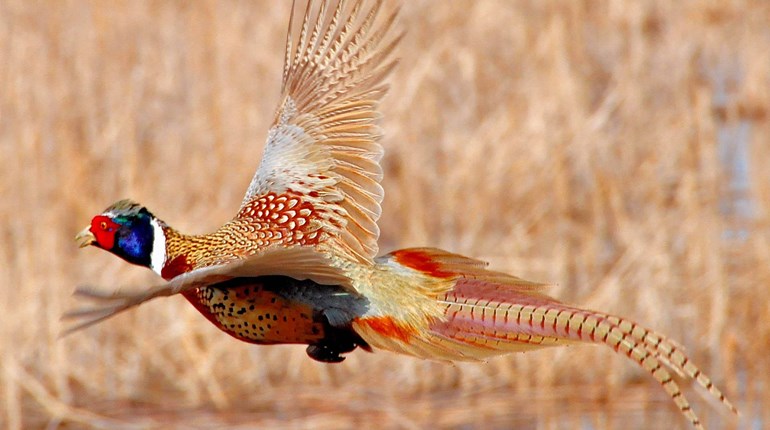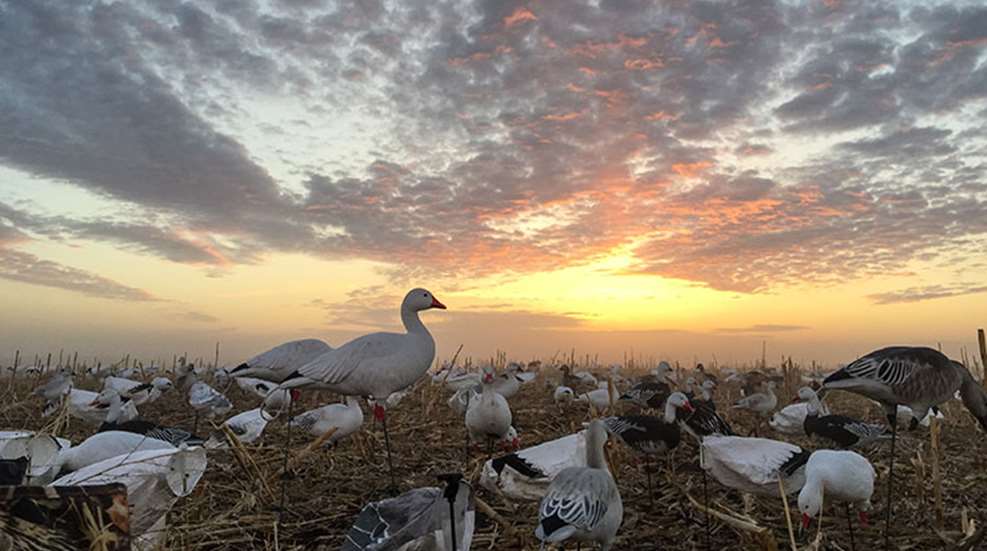
Waterfowlers are a unique subspecies within the hunting community. They’ll spend countless thousands of dollars on decoys, trailers, boats and other gear, wake up long before the sun to set out decoys in total darkness before climbing into a hole in the ground, or spend hours breaking ice on the marsh in frigid conditions—all in pursuit of a duck or goose that looks no different than its thousands of kin, and is only predictable until it’s not, because that’s bird hunting. Some call these folks crazy. Others call them brethren.
Perhaps the pinnacle of such pursuits, then, is a spring snow goose hunt. Embracing the wild ups and downs presented by the Light Goose Conservation Order requires all of that requisite dedication, alongside a healthy dash of sheer insanity. Forget basketball and brackets and Cinderella: True March Madness can be found in the eyes of goose hunters across the prairie each spring.
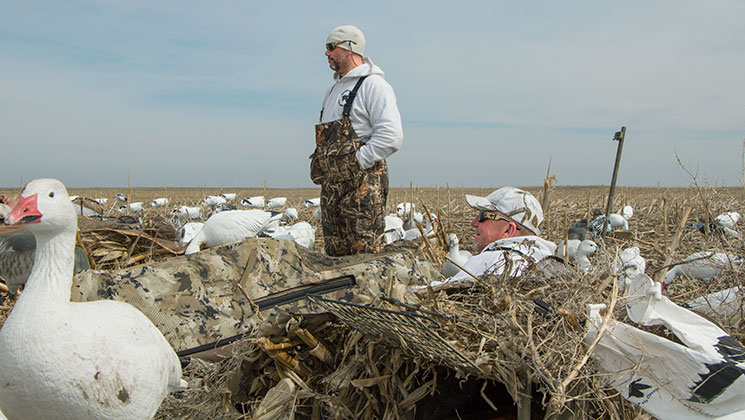
Conservation Season
To understand the allure of the spring snow goose season, it helps to understand just what it is: Since 2000, states in flyways across the nation have authorized a Light Goose Conservation Order. The framework of the order is simple: It extends the hunting season for “light geese,” a category that includes greater snows, lesser snows and Ross’ geese. Exact dates vary by region, but conservation seasons typically open in January or February and run into late March or early April. If you’re willing to chase snows back up into Canada, seasons can run as late as May.
The entire initiative was born of a late-1990s realization that the light goose population was simply out of control and unsustainable. Snow geese remain today a threat to our continent’s Arctic tundra and, by default, the countless other species of gamebirds that migrate through those same regions. State fish and game departments are free to set their own rules in regards to the Conservation Order, but the general framework remains the same. Bag limits are eliminated—or, at the very least upped considerably—electronic calls are approved, shooting hours are extended and shotguns don’t have to be plugged.
In a nutshell: Regulations are loosened and you can shoot as many of the damn things as you can bring to your gun, months after other waterfowl seasons have closed.
On paper, that sounds great. In practice, it’s an incredibly taxing bird hunt that’s not at all guaranteed to pay off. You’ve got to be pretty eaten up at the idea of killing snow geese to chase them halfway across the continent. Thing is, my dad and his hunting buddies are just that kind of crazy.
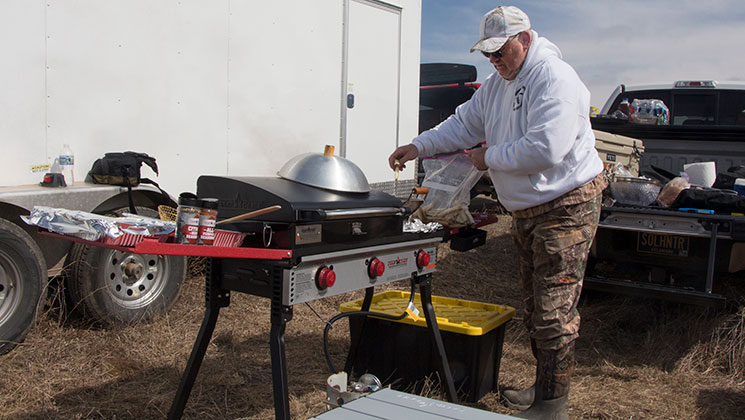
Prairie Bound
The journey from southern Delaware—where my dad, Pat Skipper, and his crew call home—to northeastern South Dakota runs about 24 hours. Last year American Hunter Managing Editor Jon Draper and I joined the convoy in Frederick, Md., a couple hours into the journey. The plan was: three men and the dog (our trusty golden retriever, Tank) in one truck, the other two fellas in a second vehicle. Once we hit South Dakota we’d be joined by a pair of my dad’s hunting buddies from Manitoba, Canada. Such is the call of the light goose and good company that we had a couple of guys purposefully leaving the Great White North to come hunt birds in the Lower 48.
The ride was simple enough in itself: a lot of time spent on I-80 West, checking migration reports on the phone and waiting anxiously to see if the outfitter would be sending along good news. Not that we’d have turned around, but a little excitement makes the 24-hour ride palatable. We passed the hours in the lead truck listening to college basketball games and the World Baseball Classic on the radio, and debating who slept more, Draper or the dog—probably too close to call, to be honest. Occasional stops for gas, restroom breaks or food were essentially pre-programmed—Dad’s done the drive countless times now, and knows every place worth stopping at along the way.
Our outfitter, Goosehog Outdoors, came highly recommended. Among its tactics is a 10,000-decoy spread that we had booked for the first weekend of our stay. Thing is, a 10,000-decoy spread isn’t very mobile, and along the way we learned the birds were moving elsewhere, so we’d be taking a different rig and doing a bit of chasing instead. Undeterred, we settled into our hotel, had a few drinks among friends and tried to rest up before day one. It’d be a long week lying on our backs in cornfields. Best to be ready.
I’ll preface this next part by making it clear that a big part of what makes spring snow goose hunting so addictive is sheer volume. When it’s good, it’s nearly indescribable. You’ve probably heard tell—or maybe even seen the photos—of triple-digit days, more than 100 birds taken in one hunt, sometimes with just a handful of guns working, or volleys that drop two dozen birds at a time. These things can, and do, happen. But if it were easy, or those things common, it wouldn’t be such a challenge. Sometimes the birds don’t fly, other times they’re in the sky but more focused on their migration than stopping to feed. And other times still they seem to blow you off for no real reason at all.
The first day in South Dakota last March was one of those days. By the time we broke for lunch—which hunting buddy Rick prepared at the edge of the field using some of the latest Camp Chef products—we’d killed a single bird. I still hadn’t heard the report of my shotgun. Don’t get me wrong, we rallied a bit in the afternoon, and absolutely got into the birds as the week went on—we even have photo evidence. But on some days, those white devils win.
And that’s the reason Dad’s best advice to some people who ask about making the trip is simply, “Put away your gun and stay home.” He’s only half-joking. It was simply too late for those of us on this trip; we’d already been hooked.
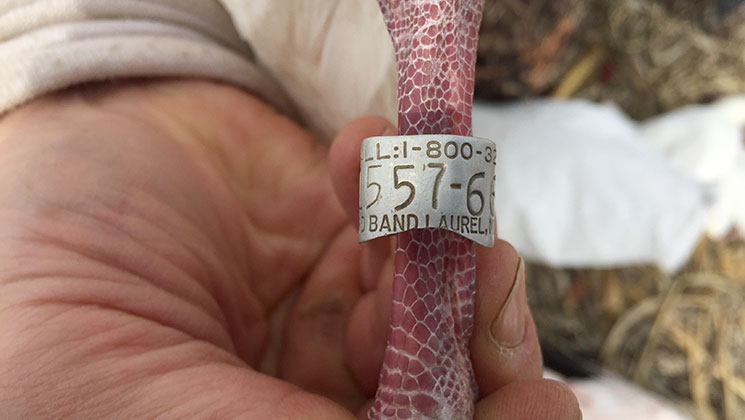
Senior Citizen
Though there are certainly plenty of birds worthy of mounting in your den, waterfowl hunters don’t often hunt for “trophies” in the traditional sense. One thing bird hunters can and often do collect, however, is bands. Migratory birds of varying species are banded by federal agencies, which use the data collected when a hunter reports a band number—most notably, where it was killed—to further research initiatives. For many duck and goose hunters, killing a banded bird is a rare treat. If you’re willing to voluntarily report the band’s number to the proper authorities, you learn a little bit about the bird you just waxed, too.
We killed two banded snow geese in South Dakota, one of which raised a few eyebrows. Just before breaking for lunch one day, a pair of Ross’ geese came into the spread hot, buying it without question. That earned them a volley of steel, and before long the dog had work to do. Both geese looked rather old, with their beaks all warted up. One of them was banded, and right away something seemed different: The band’s numbers weren’t as clear as they normally are, and the band itself may have fallen off the goose’s leg given another season or two. It wasn’t in great shape. So when the lunch bell sounded, I decided to report the bird and get a little intel.
Using my phone, I submitted the standard report online. To my surprise, I was initially met with the following message: “Potential problems were detected with this report: This bird or band is unusually old. Please recheck your data, correct it if it is needed and include any important remarks in the comments field. If no changes are needed, press continue.”
I double-checked the band’s number, scratched my head and submitted the report a second time. When the results loaded, I understood why the number was kicked back to me: the female Ross’ goose it was attached to was listed as having been hatched in, and I quote, “1999, or earlier.”
Given that she’d lived her last day in March 2017, we were looking at an 18-year-old (or older) goose. It wasn’t the oldest on record, by any means, but it was well above average, and the oldest bird I’d ever seen reported. The Bird Banding Laboratory has seen a few Ross’ in that age range before, including a bird aged 22 years, 6 months, which was killed in California in 1993. What finally led our bird and her partner to the gun—and how many pellets had probably just narrowly missed her in the past—we’ll never know.
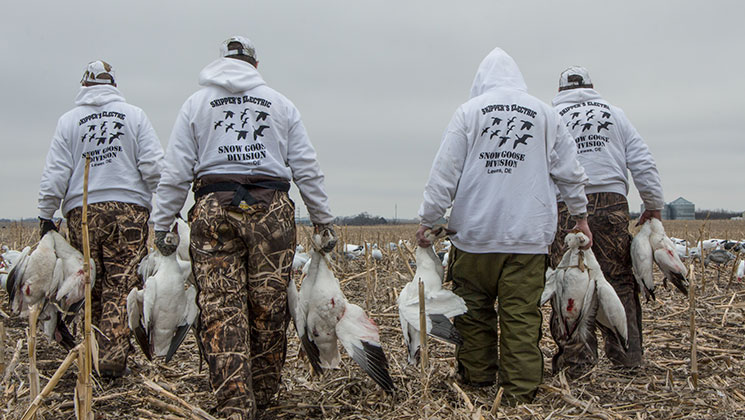
The Addiction
And so the week wore on, and more birds met their maker. We never did get into one of the fabled triple-digit days, but chasing that dream is what brings people back—same as catching a fleeting glimpse of a true Boone & Crockett buck. It may not happen the first time, or the fifth or even the 50th. But you’ll keep pursuing it anyway—and that’s the spirit of the whole thing. But our adventure had been everything we’d hoped for. We’d chased the dream, sure, but waterfowl hunting’s a heck of a lot more than having a pile of birds at the end of the day. We laughed, we cajoled and enjoyed good times with better people. Squeezing into a layout blind and hoping the near-frozen remains of last season’s corn harvest are kind to your back isn’t the most comfortable way to spend a week on the windy plains of the Midwest, but most waterfowlers will agree it sure as hell beats a week of work.
It’s a week that’ll wear you down, though, for sure, which is why I usually take a year off between such road trips. Dad and whatever crew he can assemble, though, surely have plans to return to South Dakota this year for one of two conservation season hunts he’s got planned. But, hey, like I said, chasing snow geese requires a dash of crazy. He just happens to have it in spades.












